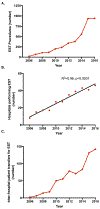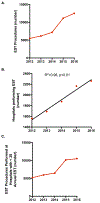Real-World Treatment Trends in Endovascular Stroke Therapy
- PMID: 30726185
- PMCID: PMC6407696
- DOI: 10.1161/STROKEAHA.118.023967
Real-World Treatment Trends in Endovascular Stroke Therapy
Abstract
Background and Purpose- Recent landmark trials provided overwhelming evidence for effectiveness of endovascular stroke therapy (EST). Yet, the impact of these trials on clinical practice and effectiveness of EST among lower volume centers remains poorly characterized. Here, we determine population-level patterns in EST performance in US hospitals and compare EST outcomes from higher versus lower volume centers. Methods- Using validated diagnosis codes from data on all discharges from hospitals and Emergency Rooms in Florida (2006-2016) and the National Inpatient Sample (2012-2016) we identified patients with acute ischemic stroke treated with EST. The primary end point was good discharge outcome defined as discharge to home or acute rehabilitation facility. Multivariate regressions adjusted for medical comorbidities, intravenous tPA (tissue-type plasminogen activator) usage and annual hospital stroke volume were used to evaluate the likelihood of good outcome over time and by annual hospital EST volume. Results- A total of 3890 patients (median age, 73 [61-82] years, 51% female) with EST were identified in the Florida cohort and 42 505 (median age, 69 [58-79], 50% female) in the National Inpatient Sample. In both Florida and the National Inpatient Sample, the number of hospitals performing EST increased continuously. Increasing numbers of EST procedures were performed at lower annual EST volume hospitals over the studied time period. In adjusted multivariate regression, there was a continuous increase in the likelihood of good outcomes among patients treated in hospitals with increasing annual EST procedures per year (odds ratio, 1.1; 95% CI, 1.1-1.2 in Florida and odds ratio, 1.3; 95% CI, 1.2-1.4 in National Inpatient Sample). Conclusions- Analysis of population-level datasets of patients treated with EST from 2006 to 2016 demonstrated an increase in the number of centers performing EST, resulting in a greater number of procedures performed at lower volume centers. There was a positive association between EST volume and favorable discharge outcomes in EST-performing hospitals.
Keywords: endovascular procedures; population health; procedures and techniques utilization; stroke; thrombectomy.
Figures




References
-
- Saver JL, Goyal M, Bonafe A, Diener H- C, Levy EI, Pereira VM, et al. Stent-Retriever Thrombectomy after Intravenous t-PA vs. t-PA Alone in Stroke. N. Engl. J. Med 2015; 372:2285–2295. - PubMed
-
- Berkhemer OA, Fransen PSS, Beumer D, van den Berg LA, Lingsma HF, Yoo AJ, et al. A Randomized Trial of Intraarterial Treatment for Acute Ischemic Stroke. N. Engl. J. Med 2015;372:11–20. - PubMed
-
- Campbell BCV, Mitchell PJ, Kleinig TJ, Dewey HM, Churilov L, Yassi N, et al. Endovascular Therapy for Ischemic Stroke with Perfusion-Imaging Selection. N. Engl. J. Med 2015;372:1009–1018. - PubMed
-
- Goyal M, Demchuk AM, Menon BK, Eesa M, Rempel JL, Thornton J, et al. Randomized Assessment of Rapid Endovascular Treatment of Ischemic Stroke. N. Engl. J. Med 2015;372:1019–1030. - PubMed
-
- Jovin TG, Chamorro A, Cobo E, de Miquel MA, Molina CA, Rovira A, et al. Thrombectomy within 8 Hours after Symptom Onset in Ischemic Stroke. N. Engl. J. Med 2015;372:2296–2306. - PubMed
Publication types
MeSH terms
Substances
Grants and funding
LinkOut - more resources
Full Text Sources
Other Literature Sources
Medical
Research Materials

